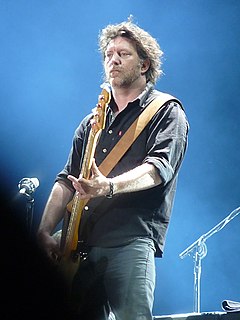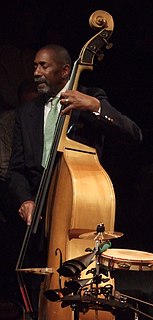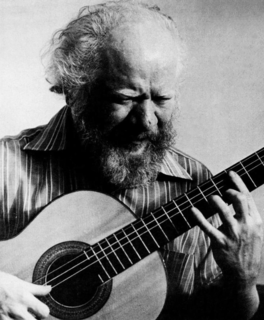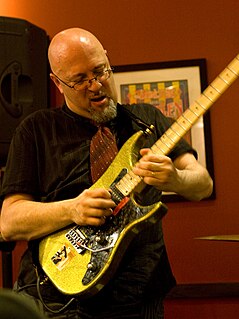
Jean Reinhardt, known to all by his Romani nickname Django, was a Belgian-born Romani-French jazz guitarist and composer. He was the first major jazz talent to emerge from Europe and remains the most significant.

The term jazz guitar may refer to either a type of electric guitar or to the variety of guitar playing styles used in the various genres which are commonly termed "jazz". The jazz-type guitar was born as a result of using electric amplification to increase the volume of conventional acoustic guitars.

In music performances, rhythm guitar is a technique and role that performs a combination of two functions: to provide all or part of the rhythmic pulse in conjunction with other instruments from the rhythm section ; and to provide all or part of the harmony, i.e. the chords from a song's chord progression, where a chord is a group of notes played together. Therefore, the basic technique of rhythm guitar is to hold down a series of chords with the fretting hand while strumming or fingerpicking rhythmically with the other hand. More developed rhythm techniques include arpeggios, damping, riffs, chord solos, and complex strums.

John McLaughlin is an English guitarist, bandleader, and composer. A pioneer of jazz fusion, his music combines elements of jazz with rock, world music, Indian classical music, Western classical music, flamenco, and blues. After contributing to several key British groups of the early 1960s, McLaughlin made Extrapolation, his first album as a bandleader, in 1969. He then moved to the U.S., where he played with Tony Williams's group Lifetime and then with Miles Davis on his electric jazz-fusion albums In a Silent Way, Bitches Brew, Jack Johnson, and On the Corner. His 1970s electric band, the Mahavishnu Orchestra, performed a technically virtuosic and complex style of music that fused electric jazz and rock with Indian influences.

The highly diverse and distinctive music of Madagascar has been shaped by the musical traditions of Southeast Asia, Africa, Arabia, England, France and the United States over time as indigenous people, immigrants, and colonists have made the island their home. Traditional instruments reflect these widespread origins: the mandoliny and kabosy owe their existence to the introduction of the guitar by early Arab or European seafarers, the ubiquitous djembe originated in mainland Africa and the valiha—the bamboo tube zither considered the national instrument of Madagascar—directly evolved from an earlier form of zither carried with the first Austronesian settlers on their outrigger canoes.

Ferdinando Maria Meinrado Francesco Pascale Rosario Carulli was an Italian composer for classical guitar and the author of the influential Méthode complète pour guitare ou lyre, op. 27 (1810), which contains music still used by student guitarists today. He wrote a variety of works for classical guitar, including numerous solo and chamber works and several concertos. He was an extremely prolific writer, composing over 400 works for the instrument.

Hunter Benedict Shepherd is an American musician, best known as the bassist of the rock band Soundgarden from 1990 to 2017.

Jazz bass is the use of the double bass or bass guitar to improvise accompaniment ("comping") basslines and solos in a jazz or jazz fusion style. Players began using the double bass in jazz in the 1890s to supply the low-pitched walking basslines that outlined the chord progressions of the songs. From the 1920s and 1930s Swing and big band era, through 1940s Bebop and 1950s Hard Bop, to the 1960s-era "free jazz" movement, the resonant, woody sound of the double bass anchored everything from small jazz combos to large jazz big bands.

A guitar technician is a member of a music ensemble's road crew who maintains and sets up the musical equipment for one or more guitarists. Depending on the type and size of band, the guitar tech may be responsible for stringing, tuning, and adjusting electric guitars and acoustic guitars, and maintaining and setting up guitar amplifiers and other related electronic equipment such as effect pedals.

Severino Dias de Oliveira, known professionally as Sivuca, was a Brazilian accordionist, guitarist and singer. In addition to his home state of Paraíba, Brazil, and cities Recife and Rio de Janeiro, he worked and lived in Paris, Lisbon, and New York City intermittently. He has two daughters, Wilma Da Silva and Flavia de Oliveira Barreto.

Eusèbe Jaojoby, commonly known by his surname Jaojoby[ˈdzodzubʲ], is a Malagasy composer and singer of salegy, a musical style of northwestern Madagascar. Critics consider him to be one of the originators of the modern salegy style that emerged in the 1970s, and credit him with transforming the genre from an obscure regional musical tradition into one of national and international popularity. Jaojoby also contributed to the creation of two salegy subgenres, malessa and baoenjy. Jaojoby has been called the most popular singer in Madagascar and the Indian Ocean islands, and is widely referred to as the "King of Salegy". His success has earned him such honors as Artist of the Year in Madagascar for two consecutive years (1998–1999) and the role of Goodwill Ambassador for the United Nations Population Fund in 1999.

The culture of Madagascar reflects the origins of the people Malagasy people in Southeast Asia and East Africa. The influence of Arabs, Indians, British, French and Chinese settlers is also evident. The most emblematic instrument of Madagascar, the valiha, is a bamboo tube zither carried to the island by early settlers from southern Borneo, and is very similar in form to those found in Indonesia and the Philippines today. Traditional houses in Madagascar are likewise similar to those of southern Borneo in terms of symbolism and construction, featuring a rectangular layout with a peaked roof and central support pillar. Reflecting a widespread veneration of the ancestors, tombs are culturally significant in many regions and tend to be built of more durable material, typically stone, and display more elaborate decoration than the houses of the living. The production and weaving of silk can be traced back to the island's earliest settlers, and Madagascar's national dress, the woven lamba, has evolved into a varied and refined art. The Southeast Asian cultural influence is also evident in Malagasy cuisine, in which rice is consumed at every meal, typically accompanied by one of a variety of flavorful vegetable or meat dishes. African influence is reflected in the sacred importance of zebu cattle and their embodiment of their owner's wealth, traditions originating on the African mainland. Cattle rustling, originally a rite of passage for young men in the plains areas of Madagascar where the largest herds of cattle are kept, has become a dangerous and sometimes deadly criminal enterprise as herdsmen in the southwest attempt to defend their cattle with traditional spears against increasingly armed professional rustlers.

Christophe Godin is a French guitarist and singer, known for his work with the French bands Metal Kartoon, Gnô and Mörglbl. Godin plays a variety of styles, including heavy metal, jazz fusion, blues and more.

Philibert Rabezoza, better known by the name Rakoto Frah, was a flautist and composer of traditional music of the central highlands of Madagascar. Born in 1923 near the capital city of Antananarivo to a poor rural family, Rakoto Frah surmounted the challenges posed by his underprivileged origins to become the most acclaimed 20th century performer of the sodina flute, one of the oldest traditional instruments on the island. Through frequent international concerts and music festival performances, he promoted the music of the highlands of Madagascar and became one of the most famous Malagasy artists, both within Madagascar and on the world music scene.
Paul David Harbour is an American bass guitar and guitar player, pianist and composer. He is recognised for his work with David T. Chastain, Michael Harris and Tony MacAlpine. He has played in the bands "Leather", "Chastain" and "King Diamond". He teaches bass guitar, guitar and piano.

Nicolas Vatomanga Andrianaivo Rakotovao, known as Nicolas Vatomanga is a Malagasy saxophonist, flutist, bandleader and composer. His music combines elements of jazz, blues and traditional musics of Madagascar, including: the hira gasy of the Centre, the beko from the South and the salegy from the North of the Great Island.

Paul Bert Rahasimanana, better known as Rossy, is a Malagasy singer and songwriter, generally considered the most popular Malagasy artist of the 1990s. Beginning his musical career as an accordionist and singer within a traditional hira gasy musical troupe, Rossy innovated a fusion of hira gasy instrumentation and vocal style with contemporary rock, funk and folk sounds to create a uniquely Malagasy genre of contemporary popular music. Rossy actively promoted former president Didier Ratsiraka through concert performances throughout his presidency and served within the Ministry of Culture to promote artists' rights and copyright law. When Ratsiraka fell into disfavor following the contentious 2001 Malagasy presidential elections, Rossy went into self-imposed exile in France. He returned to the island to give concerts beginning in 2008 and enjoyed enormous popularity despite six years of absence, setting an unbroken record of 35,000 tickets sold for a performance given that year. His compositions and style are frequently associated with the Ratsiraka socialist period and commonly evoke a sense of nostalgia among Malagasy fans.

Olombelona Ricky, also known as Ricky, is a Malagasy vocalist and roots musician based in Antananarivo, Madagascar. Launching his musical career in 1991, Ricky recorded his first album in 1998, sparking the phenomenon of "Rickymania". His socio-political messages and uncompromising approach to his career have earned him a strong following among urban youth within Madagascar. He is esteemed as a musical and cultural ethnologist by many of his fellow Malagasy musicians for his effort to capture and reinvent the traditional musical heritage of the island and that of the near-mythical Vazimba people in particular, believed by many Malagasy to be the island's earliest inhabitants. Despite an uncompromising approach to his career which slowed his international exposure, Ricky has performed at numerous international music festivals over the course of his career and regularly tours at home and abroad.

Samoëla Rasolofoniaina, better known as Samoëla, is a Malagasy vocalist and composer of contemporary folk fusion and roots music that draws upon musical traditions throughout the island of Madagascar. He typically sings and plays acoustic guitar, accompanied by an ensemble including bass guitar, Western and traditional percussion, and backup singers. He is distinguished by his use of hainteny traditional poetry and its metaphorical language, as well as youth slang and culturally subversive direct language to critique and address sensitive social and political topics.

Mahaleo is a folk-pop band from Madagascar that is widely viewed as the most popular Malagasy group of all time. The band was founded by Dama with six of his classmates after first performing together during the rotaka student protests at their high school on 13 May 1972. Mahaleo's lyrics draw upon the indirect language of traditional hainteny and ohabolana to expose contemporary political and social issues and invite listeners to identify their own solutions.



















